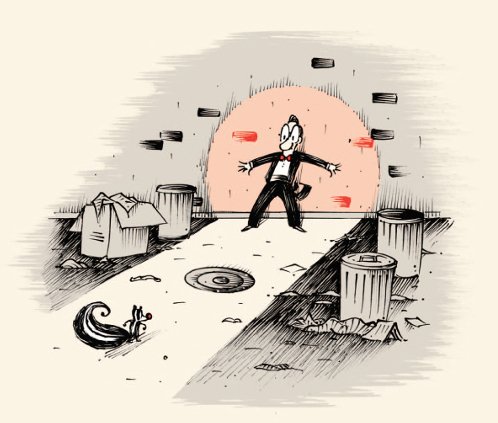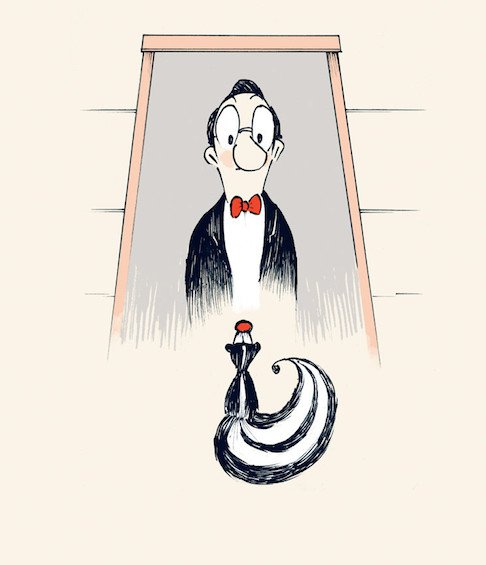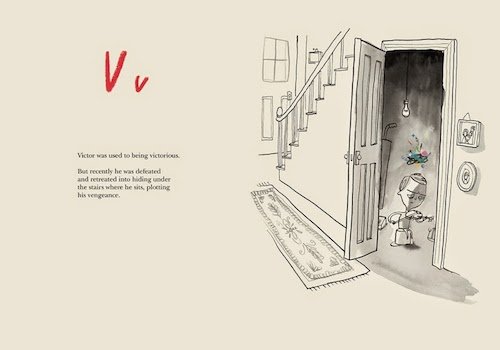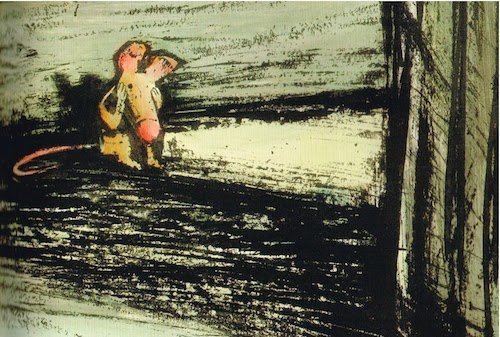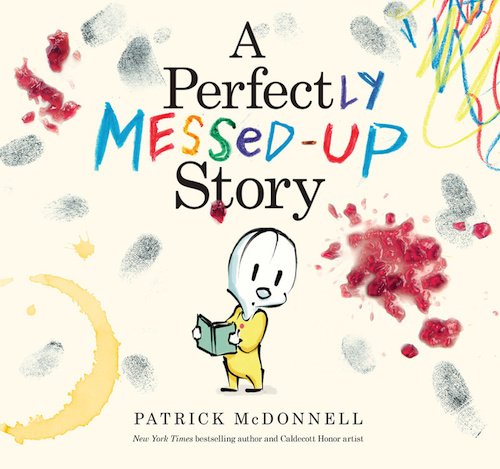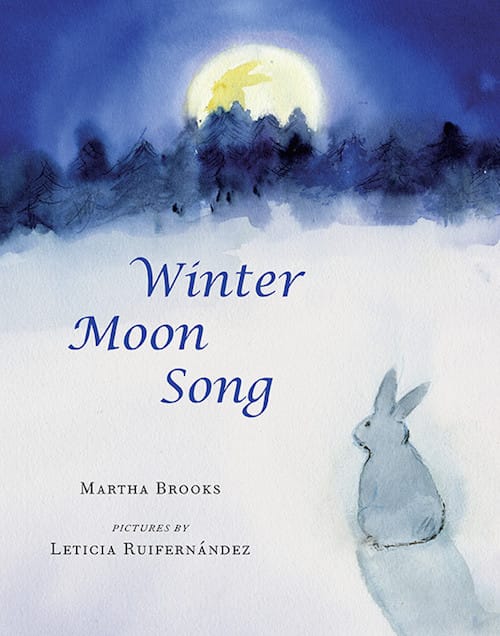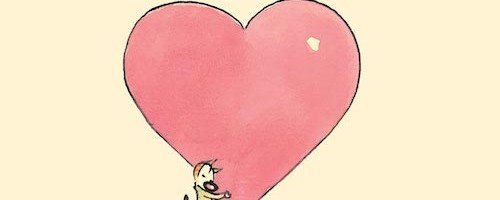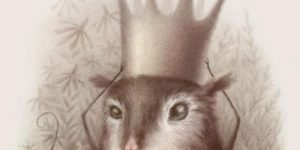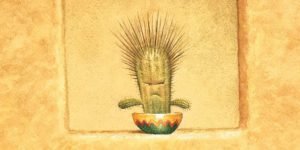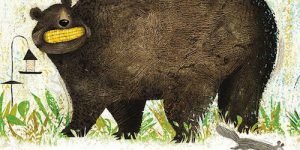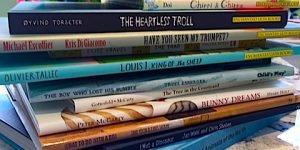There is a type of plot device I find irresistible: when a seemingly innocuous element is introduced into a story which proceeds to throw the protagonist’s life into chaos. One of the best examples is Patrick Süskind’s The Pigeon, but it doesn’t really matter, because what’s true in fiction is often true in life. For most of us, a certain predictability is desirable. Though we may rail against it, routine is stabilizing, even comforting. When it is disrupted, everything, and everyone, falls into question, and who we become in the midst of uncertainty is where the real story begins.
In Mac Barnett and Patrick McDonnell’s wonderfully sly new picture book The Skunk, a man is utterly discombobulated by the sudden appearance of chaos on his doorstep. Chaos, in this particular instance, takes the form of a skunk, as the title suggests. Not a normal skunk, which would unnerve anyone, but a skunk in dogged pursuit of some unnamed thing…or person. Impeccably dressed in a tux and bow-tie and on his way to the opera, the man does not wish to startle the skunk, so he backs away  slowly and heads down the street. The skunk follows. The creature is neither friendly nor unfriendly, but he is always there, around the corner, sitting at a nearby table, matching the man’s actions move for move. The man confronts the skunk, offering various forms of appeasement like a saucer of milk and his own pocket watch, but the skunk is not interested. His paranoia rises. The skunk continues his pursuit from cemetery to carnival, finally cornering the man on a dead-end street. We never find out the skunk’s true intent because the man jumps down the sewer and starts running until he ends up in another part of the city. He buys a new house and starts his life over. But even as he celebrates, the anxiety persists. Something is missing.
slowly and heads down the street. The skunk follows. The creature is neither friendly nor unfriendly, but he is always there, around the corner, sitting at a nearby table, matching the man’s actions move for move. The man confronts the skunk, offering various forms of appeasement like a saucer of milk and his own pocket watch, but the skunk is not interested. His paranoia rises. The skunk continues his pursuit from cemetery to carnival, finally cornering the man on a dead-end street. We never find out the skunk’s true intent because the man jumps down the sewer and starts running until he ends up in another part of the city. He buys a new house and starts his life over. But even as he celebrates, the anxiety persists. Something is missing.
“I thought about the skunk. What was he doing? Was he looking for me? Was he back in his burrow? Was he following someone else? I left the party to find my skunk.”
My skunk.
Is The Skunk the first children’s picture book to explore Stockholm Syndrome? Nah. Maybe. It would be easy to write an entire review about the psychological undercurrents in this book (I’m already half way down that path), but it would be at the cost of its other pleasures. Simply put, The Skunk is very clever storytelling. The entire idea is funny, and Barnett’s pacing is exquisite, building slowly to a twist (and slightly twisted) ending.
And then there is Patrick McDonnell’s art. McDonnell has been such a frequent subject in this blog, I should have exhausted my superlatives long ago, but his artistic brilliance continues to inspire even as my ability to praise (in an original way) shrinks. The teaming of Barnett and McDonnell is perfection on a number of levels. Considering the subject matter, one might expect the skunk to appear menacing, but just the opposite is true. McDonnell’s skunk is adorable. His bushy tail curls over like a musical note, sweetly dwarfing the rest of the skunk’s tiny body, and his facial features bare some resemblance to the loveable cat Mooch from McDonnell’s cartoon strip Mutts, especially the red, over-sized nose. Throughout the book, McDonnell’s beautifully realized illustrations – master classes in characterization and line – bring humour and light to each scene, even as the story darkens.
But the apparent innocence of the skunk is deceptive, or at least, dual-purposed. With the exception of the last scene, the skunk’s face is expressionless. Calm. This makes it impossible for the man to know the skunk’s real intent. Is it malicious, or just a poorly expressed attempt at friendship? It’s possible he is over-reacting to the situation, but then again, maybe not. Chaos. The unknowable is what drives the man to make a desperate move and start a new life on the other side of town. The funny thing is, when the skunk is no longer in pursuit, he misses it. He goes after it. The pursued becomes the pursuer. In spite of the title, The Skunk is really about the man. The skunk doesn’t change. This is why teaming McDonnell with Barnett is so perfect. If the skunk had been an obvious baddie, the story could be read in a more straightforward way, but thanks to the subtle, artful intelligence of McDonnell and Barnett, there is much more going on. More questions, more nuance, and certainly, more fun.
The Skunk is brilliant and inscrutable, and like the character(s) in the book, it will stick with you for a very, very long time.
Mac Barnett is no stranger to funny, occasionally subversive kids books. Just within the last couple of years, the prolific, California-based author has written at least two books that share a mischievous affinity with The Skunk: the take-down masterpiece Battle Bunny, and the award-winning Sam and Dave Dig a Hole, beautifully illustrated by a fellow-subverter Jon Klassen. (Barnett previously teamed with Klassen on Extra Yarn.) I am giddily looking forward to the upcoming Leo: A Ghost Story (illustrations by Christian Robinson), to be published in August.
Patrick McDonnell is the creator of the incredibly endearing, kind-hearted, and funny cartoon strip Mutts. Aside from the annual collections of his strips, McDonnell has also written and illustrated several stand-alone picture books, including the Caldecott Honor-winning Me…Jane (about Jane Goodall’s childhood), and my personal favourite South. I have reviewed most of Patrick McDonnell’s books, and rather than list them here, please click on the Picture Book Archive on the left hand side and scroll down the list for additional reviews. McDonnell is a member of the national board of directors for both the Humane Society of the United States and the Fund for Animals. His art is beautiful. He is beautiful. I can’t say enough.
THE SKUNK by Mac Barnett, illustrations by Patrick McDonnell. Published by Roaring Brook Press, 2015
For a mini-review of Battle Bunny, click HERE and scroll down. For another mini-review of Sam & Dave Dig a Hole, click HERE. (Both books deserve longer reviews, I know. Until then, I strongly recommend both books. Strongly. Recommend.)



